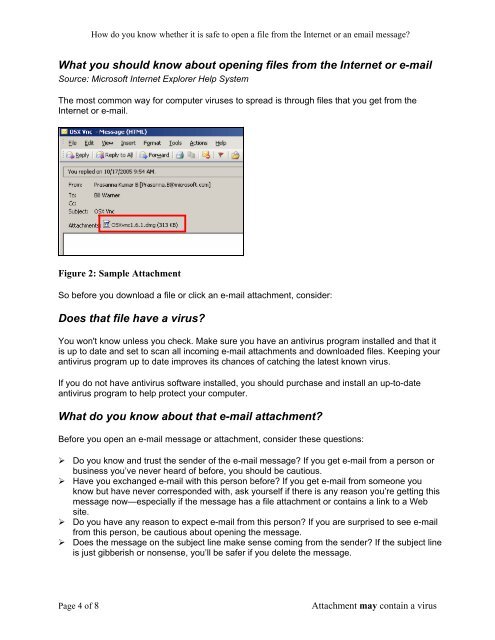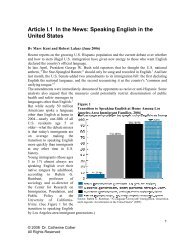How do you decide whether to open an email attachment?
How do you decide whether to open an email attachment?
How do you decide whether to open an email attachment?
- No tags were found...
You also want an ePaper? Increase the reach of your titles
YUMPU automatically turns print PDFs into web optimized ePapers that Google loves.
<strong>How</strong> <strong>do</strong> <strong>you</strong> know <strong>whether</strong> it is safe <strong>to</strong> <strong>open</strong> a file from the Internet or <strong>an</strong> <strong>email</strong> message?What <strong>you</strong> should know about <strong>open</strong>ing files from the Internet or e-mailSource: Microsoft Internet Explorer Help SystemThe most common way for computer viruses <strong>to</strong> spread is through files that <strong>you</strong> get from theInternet or e-mail.Figure 2: Sample AttachmentSo before <strong>you</strong> <strong>do</strong>wnload a file or click <strong>an</strong> e-mail <strong>attachment</strong>, consider:Does that file have a virus?You won't know unless <strong>you</strong> check. Make sure <strong>you</strong> have <strong>an</strong> <strong>an</strong>tivirus program installed <strong>an</strong>d that itis up <strong>to</strong> date <strong>an</strong>d set <strong>to</strong> sc<strong>an</strong> all incoming e-mail <strong>attachment</strong>s <strong>an</strong>d <strong>do</strong>wnloaded files. Keeping <strong>you</strong>r<strong>an</strong>tivirus program up <strong>to</strong> date improves its ch<strong>an</strong>ces of catching the latest known virus.If <strong>you</strong> <strong>do</strong> not have <strong>an</strong>tivirus software installed, <strong>you</strong> should purchase <strong>an</strong>d install <strong>an</strong> up-<strong>to</strong>-date<strong>an</strong>tivirus program <strong>to</strong> help protect <strong>you</strong>r computer.What <strong>do</strong> <strong>you</strong> know about that e-mail <strong>attachment</strong>?Before <strong>you</strong> <strong>open</strong> <strong>an</strong> e-mail message or <strong>attachment</strong>, consider these questions:‣ Do <strong>you</strong> know <strong>an</strong>d trust the sender of the e-mail message? If <strong>you</strong> get e-mail from a person orbusiness <strong>you</strong>’ve never heard of before, <strong>you</strong> should be cautious.‣ Have <strong>you</strong> exch<strong>an</strong>ged e-mail with this person before? If <strong>you</strong> get e-mail from someone <strong>you</strong>know but have never corresponded with, ask <strong>you</strong>rself if there is <strong>an</strong>y reason <strong>you</strong>’re getting thismessage now—especially if the message has a file <strong>attachment</strong> or contains a link <strong>to</strong> a Website.‣ Do <strong>you</strong> have <strong>an</strong>y reason <strong>to</strong> expect e-mail from this person? If <strong>you</strong> are surprised <strong>to</strong> see e-mailfrom this person, be cautious about <strong>open</strong>ing the message.‣ Does the message on the subject line make sense coming from the sender? If the subject lineis just gibberish or nonsense, <strong>you</strong>’ll be safer if <strong>you</strong> delete the message.Page 4 of 8Attachment may contain a virus
















